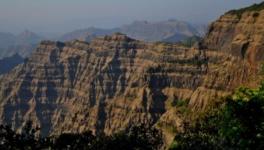Asteroid Impact That Wiped Dinos Also Created Giant Tsunami: Reveal Fossilised Megaripples
Represenattional use only.
About 66 million years ago, a giant asteroid hit Earth near what is today’s Yucatan peninsula of Mexico. The impact of the asteroid strike was such that it created a blanket of dusk that blocked sun rays for years. The results were catastrophic—temperatures went plummeting, lives went extinct en masse, including the dinosaurs. The asteroid has been estimated to be as large as 10 kilometres in diametre.
The asteroid strike also created a giant tsunami in the Gulf of Mexico (an ocean basin of the Atlantic Ocean and is surrounded by North American continent). According to scientists who have discovered ripples of the tsunami fossilised in buried sediment in current day central Lousiana, it sent a wave of upto 1,500 metres high and expanded into North America. This initial tidal wave was followed by numerous smaller waves.
While the theoretical prediction of the huge tsunami and its expanse had been made earlier, the evidence supporting it have been discovered for the first time by these group of scientists.
Led by Gary Kinsland, a geophysicist at the University of Louisiana, Lafayette, and his colleague have published their research on Chicxulub (The crater formed due to the strike of the huge asteroid), in the journal Earth and Planetary Science Letters. They reported to have found fossilised ripples in the buried sediments in the central Louisiana region. The scientists analysed a layer around 1,500 metres underground which is associated with the time of the asteroid impact. The fossilised ripples were found to be spaced about 1 km apart and 16 metres tall. The layer that the researchers analysed contained the ripples and they got fossilised.
Sean Gullick, another geophysicist at the University of Texas at Austin said in a statement to Science magazine as, “It’s great to actually have evidence of something that has been theorised for a really long time.” Gullick was not involved in the study, but was a campaigner in favour of drilling down more to the remaining of the Chicxulub crater initiated in 2016.
How the Discovery Was Made
The usual process undertaken by scientists who study ancient buried structures is the seismic imaging technique. The technique sends seismic waves deep into Earth and the waves are created by explosives or industrial hammers. The seismic waves thus sent underneath get reflected from the layers of sediments and rocks below. The reflections are converted to images to know what lies underneath. Companies searching for oil and natural gas often use this technique and there is abundance of data obtained from such endeavours in the Gulf of Mexico.
Gary Kinsland obtained seismic imaging data of the central Louisiana region from a company known as Devon Energy. Kinsland and his colleague analySed the data for a layer of about 1,500 metres below and found the megaripples fossilised in the layer.
According to Kinsland, the ripples are the imprints of the giant tsunami resulting after the asteroid impact. In his analysis, it was found that the orientation of the ripples was congruent with the asteroid impact. Kinsland said that the location was perfect for preserving the ripples. “The water was so deep that once the tsunami had quit, regular storm waves couldn’t disturb what was down there,” he added.
The latest discovery is an extension of the body of research about the Chicxulub impact, first hypothesised in 1980s. The 2016 drilling exploration (co-led by Sean Gullick as mentioned earlier) helped deciphering how the crater formed that impacted the disappearance and recovery of lives on Earth. In 2019, researchers also reported about a fossil site in North Dakota, which is situated 3,000 kilometres away from Chicxulub. The researchers in this case say that the fossils have records of debris flowing inland from the tsunami.
Get the latest reports & analysis with people's perspective on Protests, movements & deep analytical videos, discussions of the current affairs in your Telegram app. Subscribe to NewsClick's Telegram channel & get Real-Time updates on stories, as they get published on our website.
















